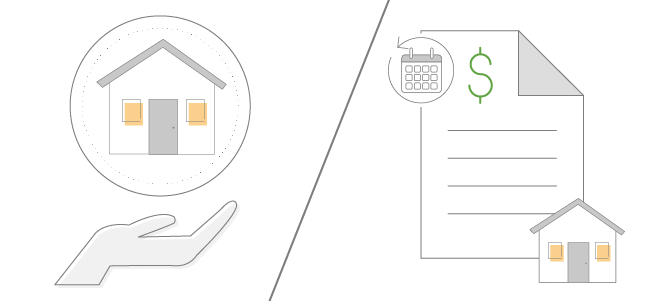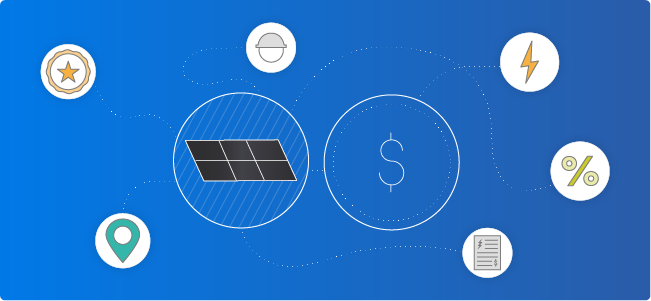Are you a good fit for solar?
Given how many solar installations there are throughout the country, you might already be able to picture what a good fit for solar looks like: a single-family, stand-alone home that you own, with a southern-facing roof that’s in good condition and receives very little shading during the day. If you read that and think, “hey, that sounds like me!” then what are you waiting for? Contact us now to get a custom solar quote from our certified solar experts.

And even if you read that and think, “hmm, not quite my situation,” fear not! Those are just a few of the factors that influence whether you’re a good fit for solar or not. Here are five questions to help you figure out whether solar panels are a good fit for you and your home.
#1. How much do you spend on electricity?
#1. How much do you spend on electricity?
There are a lot of factors that go into how much you can save with solar, but none quite as impactful as what you currently spend on electricity. The more electricity you use, and the more you pay for it, the more that you can save by going solar!
If you live in a state that experiences high electricity rates, you will save big by switching to solar power. You can still save with solar even if you use very little electricity over the course of a year or live in an area with particularly low electricity rates, but you’ll save the most if you already pay a lot for electricity (i.e., more than $100 or $150 per month for your home).
#2. What type of home do you own?
The other biggest factor in determining whether you are a good fit for solar is the type of home you live in, as well as whether you own or rent your home. In general, it’s much more difficult to install solar panels on your home if you don’t own the building. For that same reason, if you live in a multi-family property, whether renting or owning in apartments or a condo building, it may be difficult to take advantage of on-site solar.

#3. Is your roof suitable for solar?
There are a few key aspects that influence whether your roof is suitable for solar: age, material, space, shading, tilt and orientation (okay, that’s more than just a few key factors, but bear with us).
How old is your roof?
Since solar panel systems last for three decades, if your roof is near the end of its lifetime, it’s worth considering replacing it before installing solar (or rolling the roof replacement into your install). If your roof is already in good condition, great! Solar panels can help extend the life of the portion of your roof that they cover.
What is your roof made of?
You can install solar panels on nearly any type of roof material, but there are certainly materials that are easier to install on than others. Two of the more difficult roofing materials to install on are slate and wood due to how brittle they are. Luckily, Helio Solar Power is a certified roofer and is able to handle all roof types.
How big is your roof?
Do you have a wide-open roof, with significant square footage that’s free of obstacles like vents and chimneys? Or is your roof uniquely shaped with dormers and spotted with vents or other obstructions? Large, wide open roof spaces are the best for fitting the most solar panels, but even if you have limited space, you might be able to install a smaller number of high efficiency panels to produce as much power as you can with the space you do have available.
Does your roof experience lots of shading?
You can have the biggest roof in the world, but if you live next to tall buildings or trees that shade your roof all day long, you’re unfortunately not a good fit for solar. If your home is shaded for the majority of the day, it can be worth it to trim or remove trees in order to install solar panels. But don’t fret about a bit of shading throughout the day: your home doesn’t need to be perfectly sunny all of the time to benefit from a solar panel system.
What is the angle of your roof?
As a general rule of thumb, anywhere between 30 to 45 degrees is the optimal tilt (roof angle) for most solar panel systems. Thankfully, that’s the angle of most standard roofs in the US! Solar panels that are installed on a steep roof generally produce less electricity and are more difficult to install, while installing solar panels on a flat roof typically requires more space and makes more sense for larger installations (like on top of factories).
What direction does your roof face?
Your roof’s orientation, or the direction your roof faces, impacts how much electricity your solar panel system will produce. Ideally, you want your solar panels to face south to receive the most exposure to sunlight (in the Northern hemisphere, that is).
That said, while south-facing is ideal, it’s certainly not a necessity for going solar: panels facing east and west often receive more than enough sunshine to still make solar a worthwhile investment.
#4. Can you take advantage of solar incentives?
Many states, utilities and even cities offer financial incentives for going solar to help defray the cost and quicken the payback period for your solar investment. If you live somewhere with these types of incentives, you should definitely strongly consider solar.
The best financial incentive for solar is the federal investment tax credit, or ITC. Importantly: the ITC, which returns 26 percent of what you pay for solar directly to your pocket as a tax credit, is only accessible to people who have enough tax liability. In other words, if you are retired, you likely won’t be able to take full advantage of the ITC.


